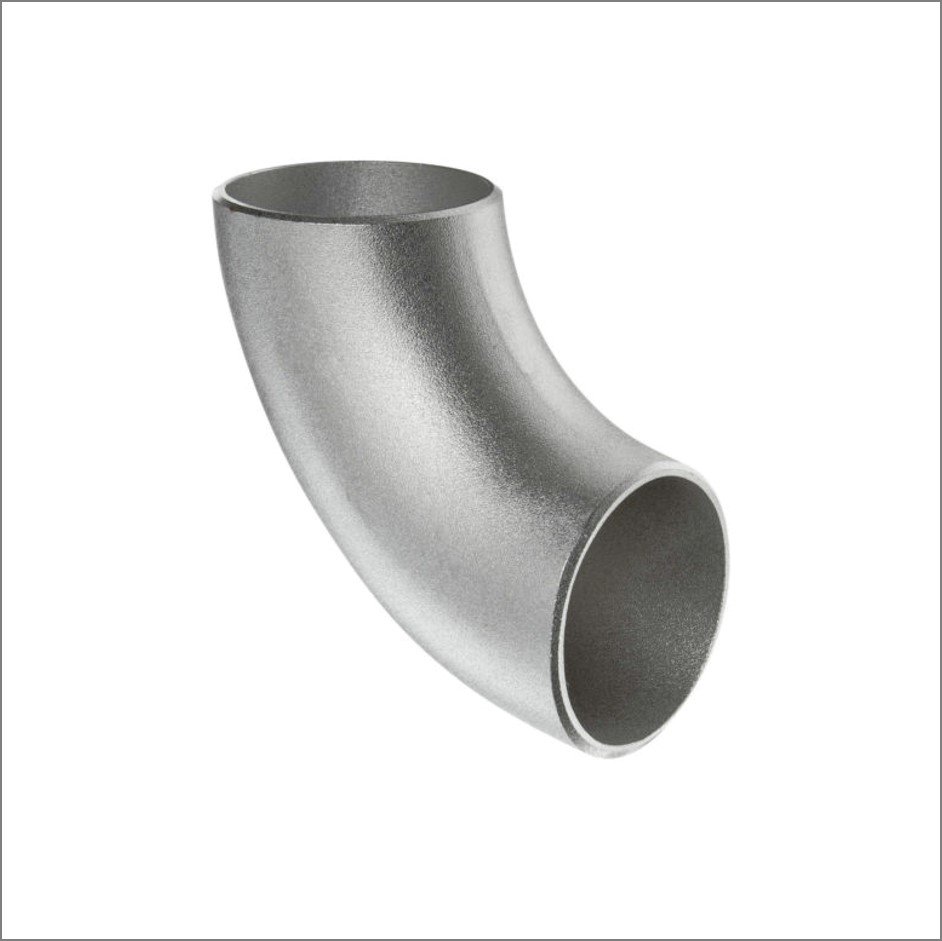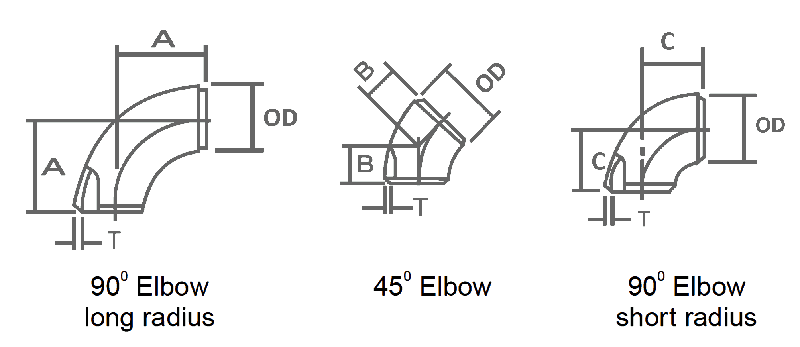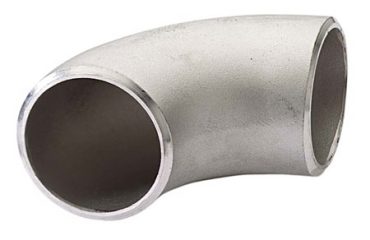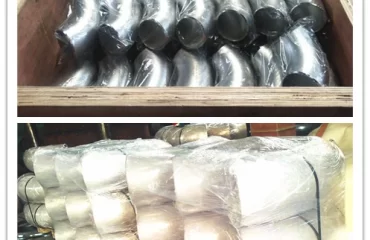
45° , 90° Elbow – 316 Stainless Steel
A 45° elbow, made from 316 stainless steel, is a pipe fitting used in plumbing and piping systems to change the direction of the flow by 45 degrees. This type of elbow is commonly used in applications where a small alteration in the path of the flow is required, rather than a full 90-degree turn.
Properties of 316 Stainless Steel
316 stainless steel is a type of austenitic stainless steel that is known for its superior corrosion resistance. It contains a high percentage of chromium and nickel, as well as a notable amount of molybdenum, which enhances its resistance to chloride corrosion compared to type 304 stainless steel. Some of the key properties of 316 stainless steel are:
- Corrosion resistance: Resistant to a wide range of chemicals and is especially resistant to marine type environments.
- High temperature resistance: It can resist scaling and retain strength at high temperatures.
- Strength: It has high tensile strength and toughness, even at cryogenic temperatures.
- Weldability: It is readily weldable by all standard methods.
Applications of a 45° Elbow – 316 Stainless Steel
Given its properties, a 45° elbow made from 316 stainless steel is suitable for use in a wide range of industrial and residential applications, including:
- Chemical Processing: Due to its excellent corrosion resistance, it is commonly used in chemical processing industries.
- Marine Applications: Its resistance to marine environments makes it suitable for marine applications.
- Food & Beverage Industry: The non-reactive nature of stainless steel makes it ideal for use in the food and beverage industry.
- Water Treatment: It is also used in water treatment plants due to its corrosion resistance.
- Construction: Its high strength and durability make it a good choice for construction and architecture.
Please note that while a 45° elbow can help change the direction of the flow, it may also cause pressure loss in the piping system. This should be taken into consideration during the design and installation of the piping system.
Stainless Steel Material
There are various stainless steels to be adapted for pipe elbow used in different applications, as we know that stainless steel exhibits excellent properties to resist corrosion, heating and high pressure, thus, stainless steel elbow is often used in critical applications.
304 and 316L are the most used stainless steel grades, they are both high chromium austenitic grades and can be met the most cases, and other grades are available, such as 321/321H and 347/347H. Some special alloys are usually for the elbow as well, like 904L, and 2205.
| Grade | Carbon | Silicon | Manganese | Chromium | Nickel | Molybdenum | Sulfur | Phosphorous |
|---|---|---|---|---|---|---|---|---|
| WP 304 | 0,08 | 1,0 | 2.00 | 18.0 – 20.0 | 8.0 – 11.0 | – | 0,03 | 0,045 |
| WP 304L | 0,035 | 1,0 | 2.00 | 18.0 – 20.0 | 8.0 – 13.0 | – | 0,03 | 0,045 |
| WP 316 | 0,08 | 1,0 | 2.00 | 16.0 – 18.0 | 10.0 – 14.0 | 2.00 – 3.00 | 0,03 | 0,045 |
| WP 316L | 0,035 | 1,0 | 2.00 | 16.0 – 18.0 | 10.0 – 15.0 | 2.00 – 3.00 | 0,03 | 0,045 |
| WP 321 | 0,08 | 1,0 | 2.00 | 17.0 – 19.0 | 9.0 – 12.0 | – | 0,03 | 0,045 |
There are also EN steel no. for opting, these equivalents include 1.4301, 1.4307, 1.4401, 1.4404, 1.4541, 1.4550, 1.4438, and 1.4539.
Elbow Length And Radius
Elbows are available in two radius types by length, Short radius (SR) and Long radius (LR), there are also other radiuses, for example, 2D, 3D and 4D.
Long Radius Elbow
Long radius elbow the radius of curvature is equal to 1.5 times the diameter of the pipe, namely, R = 1.5D, Long radius elbow is used to reduce frictional force and elbow abrasion.
Short Radius Elbow
Short radius elbow the radius of curvature is equal to the pipe diameter, short radius elbow is typically installed in the limited situation and tight spaces, it will be giving the piping a sharper turn than a long-radius elbow, However, it is a less costly option compared to LR elbow.
2D means the bending radius is 2 times the nominal pipe size, in the same way, 3D means 2 times the nominal pipe size, they are long radius elbows as well, these long radius elbows are not like 1.5D elbows frequently used, they are smoother and used for specific applications.
Elbow Direction Angle
There are three common angles of the elbow to use in the piping system, 45 degree, 90 degree and 180 degree, these angle types are to turn fluid in different directions, including right angles and return angles, there are also other angles to use, like 60 degree and 180 degree.
45 Degree Elbow
45 degree elbow changes the flow direction to 45 degrees, it includes long radius 45 degree elbow and short radius 45 degree elbow.
90 Degree Elbow
90 degree elbow changes the flow direction to 90 degrees, it also has long radius and short radius types, 90 degree elbow is the most used elbow..
180 Degree Elbow
180 degree elbow changes the flow direction to 180 degrees.
BW Elbow Dimensions

| NPS | OD | Center To End | ||
|---|---|---|---|---|
| Inch. | Mm | A | B | C |
| 1/2 | 21.3 | 38 | 16 | – |
| 3/4 | 26.7 | 29 | 11 | – |
| 1 | 33.4 | 38 | 22 | 25 |
| 1 1/4 | 42.2 | 48 | 25 | 32 |
| 1 1/2 | 48.3 | 57 | 29 | 38 |
| 2 | 60.3 | 76 | 35 | 51 |
| 2 1/2 | 73 | 95 | 44 | 64 |
| 3 | 88.9 | 114 | 51 | 76 |
| 3 1/2 | 101.6 | 133 | 57 | 89 |
| 4 | 114.3 | 152 | 64 | 102 |
| 5 | 141.3 | 190 | 79 | 127 |
| 6 | 168.3 | 229 | 95 | 152 |
| 8 | 219.1 | 305 | 127 | 203 |
| 10 | 273.1 | 381 | 159 | 254 |
| 12 | 323.9 | 457 | 190 | 305 |
| 14 | 355.6 | 533 | 222 | 356 |
| 16 | 406.4 | 610 | 254 | 406 |
| 18 | 457.2 | 686 | 286 | 457 |
| 20 | 508 | 762 | 318 | 508 |
| 22 | 559 | 838 | 343 | 559 |
| 24 | 610 | 914 | 381 | 610 |
| 26 | 660 | 991 | 406 | 660 |
| 28 | 711 | 1067 | 438 | 711 |
| 30 | 762 | 1143 | 470 | 762 |
| 32 | 813 | 1219 | 502 | 813 |
| 34 | 864 | 1295 | 533 | 864 |
| 36 | 914 | 1372 | 565 | 914 |
| 38 | 965 | 1448 | 600 | 965 |
| 40 | 1016 | 1524 | 632 | 1016 |
| 42 | 1067 | 1600 | 660 | 1067 |
| 44 | 1118 | 1676 | 695 | 1118 |
| 46 | 1168 | 1753 | 727 | 1168 |
| 48 | 1219 | 1829 | 759 | 1219 |
| All Dimensions To ASME B16.9, Unit Is In Mm | ||||
BW Elbow Weight Chart
| NPS Inches |
ELBOWS LR 90° |
ELBOWS SR 90° |
||||||
|---|---|---|---|---|---|---|---|---|
| Sch. 5S |
Sch. 10S |
Sch. 40S |
Sch. 80S |
Sch. 5S |
Sch. 10S |
Sch. 40S |
Sch. 80S |
|
| 1/2 | 0.05 | 0.06 | 0.08 | 0.10 | 0.03 | 0.04 | 0.05 | 0.07 |
| 3/4 | 0.06 | 0.07 | 0.09 | 0.11 | 0.04 | 0.05 | 0.06 | 0.07 |
| 1 | 0.09 | 0.15 | 0.18 | 0.20 | 0.06 | 0.10 | 0.12 | 0.13 |
| 1 1/4 | 0.13 | 0.20 | 0.25 | 0.35 | 0.09 | 0.13 | 0.17 | 0.12 |
| 1 1/2 | 0.18 | 0.30 | 0.40 | 0.50 | 0.12 | 0.20 | 0.27 | 0.33 |
| 2 | 0.30 | 0.50 | 0.70 | 0.90 | 0.20 | 0.33 | 0.47 | 0.60 |
| 2 1/2 | 0.60 | 0.85 | 1.35 | 1.80 | 0.40 | 0.60 | 0.90 | 1.20 |
| 3 | 0.90 | 1.30 | 2.00 | 2.90 | 0.60 | 0.90 | 1.35 | 1.90 |
| 4 | 1.40 | 2.00 | 4.00 | 5.90 | 0.90 | 1.35 | 2.65 | 3.90 |
| 5 | 2.90 | 3.60 | 6.50 | 9.70 | 1.95 | 2.40 | 4.35 | 6.50 |
| 6 | 4.00 | 5.00 | 10.5 | 16.0 | 2.70 | 3.35 | 7.00 | 10.5 |
| 8 | 7.40 | 10.0 | 21.5 | 33.5 | 4.90 | 6.70 | 14.5 | 22.5 |
| 10 | 13.6 | 16.8 | 38.5 | 52.5 | 9.10 | 11.2 | 25.6 | 35.0 |
| 12 | 23.4 | 27.0 | 59.0 | 79.0 | 15.6 | 18.0 | 39.5 | 53.0 |
| 14 | 29.0 | 35.0 | 70.0 | 94.0 | 19.3 | 23.5 | 47.0 | 63.0 |
| 16 | 41.3 | 47.0 | 95.0 | 125 | 27.5 | 31.5 | 63.5 | 84.0 |
| 18 | 51.8 | 59.0 | 120 | 158 | 34.5 | 39.5 | 80.0 | 105 |
| 20 | 73.0 | 85.0 | 146 | 194 | 49.0 | 57.0 | 98.0 | 129 |
| 24 | 122 | 140 | 210 | 282 | 82.0 | 94.0 | 140 | 188 |
| Approximate Weights In Kg, Density 8 Kg/Dm3 | ||||||||
Dimensional Tolerances Of Butt Weld Elbows
45° and 90° – LR and 3D elbow conform to ASME B16.9.
| Nominal Pipe Size | 1/2 To 2.1/2 | 3 To 3.1/2 | 4 | 5 To 8 |
|---|---|---|---|---|
| Outside Diameter At Bevel (D) |
+ 1.6 – 0.8 |
1.6 | 1.6 | + 2.4 – 1.6 |
| Inside Diameter At End | 0.8 | 1.6 | 1.6 | 1.6 |
| Center To End LR (A/B) | 2 | 2 | 2 | 2 |
| Center To End 3D (A/B) | 3 | 3 | 3 | 3 |
| Nominal Pipe Size | 10 To 18 | 20 To 24 | 26 To 30 | 32 To 48 |
| Outside Diameter At Bevel (D) |
+ 4 – 3.2 |
+ 6.4 – 4.8 |
+ 6.4 – 4.8 |
+ 6.4 – 4.8 |
| Inside Diameter At End | 3.2 | 4.8 | + 6.4 – 4.8 |
+ 6.4 – 4.8 |
| Center To End LR (A/B) | 2 | 2 | 3 | 5 |
| Center To End 3D (A/B) | 3 | 3 | 6 | 6 |
| Wall Thickness (T) | Not Less Than 87.5% Of Nominal Wall Thickness | |||




You must be logged in to post a comment.